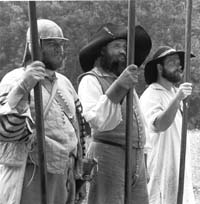 |
|
| A recreation of the Dove |
Initial Planning

A recreation of the Dove
Execution
Following these initial recommendations, Maryland held a series of events throughout 1984 to celebrate Maryland's birth, including scholarly lectures, museum exhibits, and festivals. While the celebration was a year long, it was the festivities held on Maryland Day and Charter Day which highlighted 1984. The Maryland Day events began with a reenactment of the landing at St. Clements Island, and were also to include a recreation of a 17th Century mass and a choral program. Unfortunately for the State, the day was plagued by terrible weather which truncated the events and sent three men to the hospital for exposure (Attorney General Stephen Sachs joked that they were going to change the name of the island from St. Clements to Inclement). Despite this, over 4,200 people showed up, including Governor Hughes who helped lead a band of people in "Happy Birthday". From there the party moved north to St. Mary's City where festivities were again altered by the weather, as the speeches and special joint session of legislature had to be moved to the St. Mary's College gymnasium. Among those attending the ceremonies were representatives from England, including Lord Eden, direct descendant of Robert Eden, the last English governor of Maryland. Also present were religious leaders, most notably Archbishop James Hickey.
Despite the less than spectacular outcome of the Maryland Day celebrations, the Charter Day activities were a tremendous success. These ceremonies revolved around the June 21st arrival of the Duke and Duchess of Kent to Maryland. Marylanders had been anticipating a visit from royalty for over a year, but the initial hope had been that Prince Charles and Princess Diana would be the guests. That arrangement did not work out, but based on the enthusiastic quotes which fill the newspapers and the level of media coverage, there was not too much disappointment. After a day of official ceremonies and state dinners, the royals left Annapolis on the 22nd to see the rest of Maryland. Their day-long tour ran the cultural gamut from a meeting with the Future Farmers of America in the morning to a nighttime reception at the Walters Art Gallery. On June 23rd, the royal couple trekked to Saint Mary's City where they helped Governor Hughes dedicate the opening of the St. Mary's City Historical Park. One of the stops on the Duke and Duchess' tour was Lord Baltimore's World. This living history park was in St. Mary's County and was open from May to July of 1984. It featured actors and actresses portraying Leonard Calvert, Margaret Brent, and typical citizens from 17th century Maryland. I was just six years old at the time, but I can still recall watching a sword swallower perform; even more vivid is my recollection of winning tickets in a drawing and being able to return a second time. While Lord Baltimore's World and the Charter and Maryland Day celebrations were fun, they were also important economic boons to Southern Maryland.

The Duke of Kent presents Gov. Hughes with a copy of the Maryland Charter. Pictured left to right are: the Duchess of Kent, the Duke, Gov. Hughes, Mrs. Hughes and Dr. Papenfuse.

A pair of scenes from Lord Baltimore's World
 By
late November, at least 400,000 tourists had pumped $8 million into the
economies of St. Mary's, Charles, and Calvert Counties. Spending
money was easy during the 350th Anniversary, because there was plenty
to buy. License plates, mugs, stamps, coins, and even a special
ice cream flavor (Chesapeake Wild Berry Ripple) were among the array
of choices for the historically minded consumer. Despite its obvious
importance, Maryland's Sesquitricentennial was not the only historical
anniversary being celebrated at the time. There were also events
marking the bicentennial of the resignation of George Washington
as Commander-in-Chief of the Continental Army in December of 1983 and the
Ratification of Treaty of Paris in January of 1984.
By
late November, at least 400,000 tourists had pumped $8 million into the
economies of St. Mary's, Charles, and Calvert Counties. Spending
money was easy during the 350th Anniversary, because there was plenty
to buy. License plates, mugs, stamps, coins, and even a special
ice cream flavor (Chesapeake Wild Berry Ripple) were among the array
of choices for the historically minded consumer. Despite its obvious
importance, Maryland's Sesquitricentennial was not the only historical
anniversary being celebrated at the time. There were also events
marking the bicentennial of the resignation of George Washington
as Commander-in-Chief of the Continental Army in December of 1983 and the
Ratification of Treaty of Paris in January of 1984.
Sources:
-Maryland 350th Anniversary Topic File MSA SC 1456-676
-Harry R. Hughes Collection MSA
SC 4975
Prepared by Craig Patterson and Andrew Krug, August 1998
|
Tell Us What You Think About the Maryland State Archives Website!
|
© Copyright April 21, 2006 Maryland State Archives